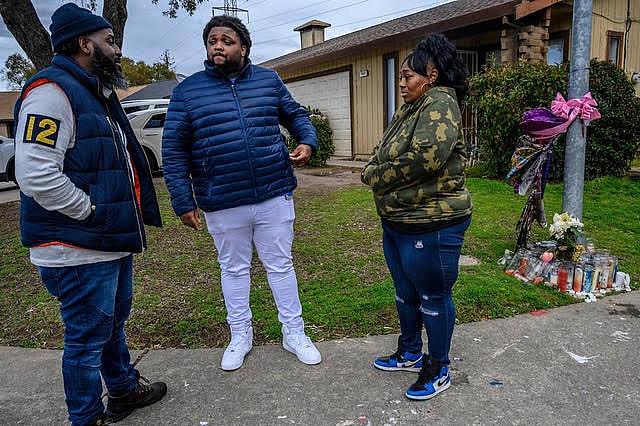A crime reporter juggles beat duty to tell deeper story of domestic violence in Sacramento’s black community

Berry Accius visits Dajha Richards’ mother and step-father near a memorial for Dajha, who was shot and killed.
Photo: Renée C. B
I recently wrote about a domestic violence homicide in south Sacramento, one of the city’s neediest enclaves, that claimed the life of a 19-year-old mother and left her family and much of her community shattered.
Initially, I had wanted to focus my project on domestic violence incidents and homicides in the county broadly, tracking the data, showing their growth, and exploring how gaps in county resources failed to address the needs of families caught in the throes of domestic violence. But then on January 8, Dajha Richards died. As The Sacramento Bee’s crime reporter, I had only intended to write a daily story about the shooting that left her dead. But as I combed through her social media accounts and read her posts in which she documented the swings of pain and love she felt in her relationship with her boyfriend (now accused of her murder), I realized her life and death merited more attention.
On a Tuesday morning, the four-month anniversary of her son’s birth, Richards was allegedly shot by her boyfriend in her home. The shooting was the fatal culmination of a years-long abusive relationship that Richards was taking steps to leave, her family told me. She was 19. Her boyfriend turned himself into police the next day.
At the vigil the night after her death, mourners stood in the rain and wept. As a black community activist spoke out against domestic violence, condemning it in the African American community and urging people to stop perpetuating a “culture of silence,” women in the crowd began sharing their experiences. A large portion of the crowd, all black women, told their stories of abuse, conveying a palpable sense of pain and loss.
The high incidence of domestic violence in the African American community has been covered before and is well-researched in academia, but I think the issue deserved a deeper dive in Sacramento — especially south Sacramento, where there are higher rates of poverty, chronic illness and crime. This area of the capital has received more attention in the last year since the death of Stephon Clark, who was shot by police less than five miles from Richard's home. The Parkway neighborhood in south Sacramento County, across the freeway from where Richards lived, has the highest number of people seeking domestic violence resources, according to county data from the Family Justice Center.
The first part of my 2018 California Fellowship project chronicles Dajha’s story and the persistent, disproportional issue of domestic violence in the black community. The second part delves into efforts to offer more resources for domestic violence victims in underserved neighborhoods.
Here are some of the takeaways I learned while researching and reporting this project:
Be flexible: I hit a number of bumps in the road while reporting this project, primarily when it came to making time for it in addition to the daily commitments of crime reporting. Newsroom layoffs and shifting editors made it difficult at times to build a schedule for this series. I found the best way to move ahead was scheduling two weeks where I could work on the stories full time, and devoting weekends to meeting sources and developing relationships. Some of the most important moments were earned by spending Sunday afternoons with Dajha’s family. Taking a week off daily reporting may not be feasible for some, but it was definitely the time I needed to get this project finished.
Don’t be afraid to ask the “stupid” questions: I had never written about domestic violence before this project, and there was a lot I didn’t know about the field. Given that it’s such a sensitive issue, it can be daunting to ask those questions you might deem “stupid,” especially when you’re speaking with victims and their families. Put the time into building trust with your sources, victims and experts alike, and ask those questions, because chances are your readers will be wondering about the same things.
Find your sounding board: I had a colleague in my newsroom who proved indispensable when working on this project early on. Since I was changing editors every few months, I’d share my reporting and research with her and she would help me sort through it and direct it. I bounced a lot of ideas off her and she helped me take my project in a direction I didn’t initially see. Find someone you trust and make them your sounding board. It’ll help keep you sane.
Be prepared to adapt: The stories I ended up writing were nothing like the project I envisioned early on. I had to change my proposal after moving to a new beat and seeing dramatic changes to our staffing at work. I realized the ambitious project I had pitched was no longer feasible. Then I faced setbacks from multiple breaking news events: several California wildfires, four fatal officer-involved shootings, and countless homicides — all news that put my project on the back burner for a time. Almost nothing went as planned. But when the breaking news subsided, I was able to carve out some time and make progress, even though not as quickly as I would have liked. So, it’s smart to make a schedule to keep yourself accountable, but be prepared to step away from it when news breaks.

